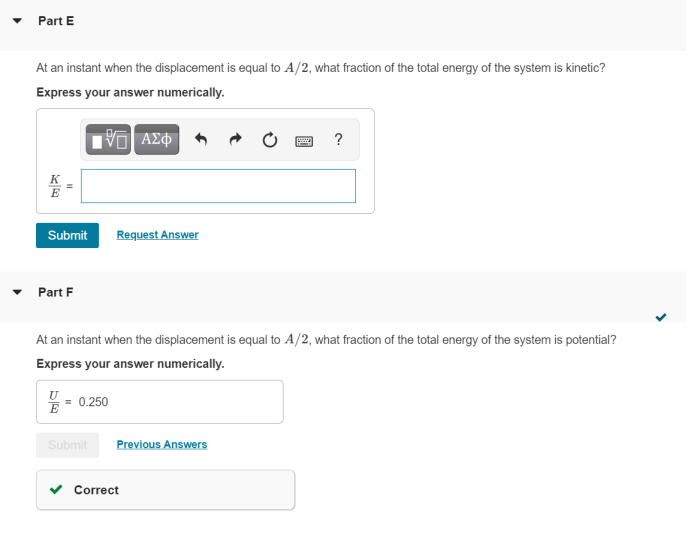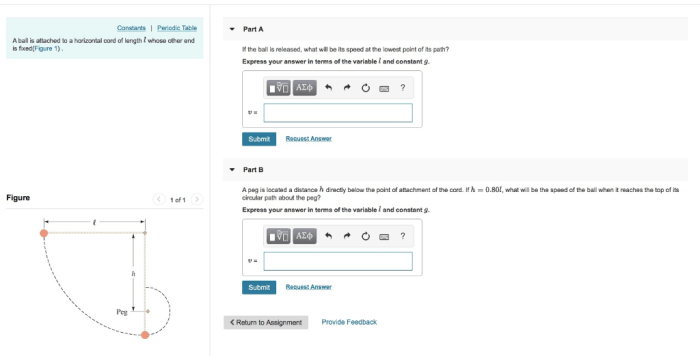A harmonic oscillator has angular frequency ω and amplitude a – A harmonic oscillator, characterized by its angular frequency ω and amplitude a, exhibits a fascinating periodic motion that underlies numerous physical phenomena. This comprehensive exploration delves into the intricacies of harmonic oscillators, examining their defining parameters, dynamics, and practical applications.
Angular frequency (ω), a crucial parameter, determines the oscillator’s oscillation rate, while amplitude (a) governs the extent of its displacement from equilibrium. These parameters, intertwined with the equation of motion, dictate the oscillator’s behavior, influencing its energy distribution and response to damping forces.
Angular Frequency (ω)

Angular frequency (ω) measures the rate of change of phase in a harmonic oscillator. It is defined as the rate of change of the phase angle with time and is expressed in radians per second (rad/s).
The angular frequency is given by the equation:
ω = 2πf
where:
- ω is the angular frequency in radians per second
- f is the frequency in Hertz (Hz)
The angular frequency is inversely proportional to the period of oscillation (T), which is the time it takes for the oscillator to complete one full cycle. The relationship between angular frequency and period is given by:
ω = 2π/T
Amplitude (a)

The amplitude (a) of a harmonic oscillator is the maximum displacement of the oscillator from its equilibrium position. It is a measure of the strength of the oscillation and is expressed in meters (m).
The displacement of a harmonic oscillator as a function of amplitude is given by the equation:
x = a*cos(ωt)
where:
- x is the displacement in meters
- a is the amplitude in meters
- ω is the angular frequency in radians per second
- t is the time in seconds
The amplitude of an oscillation can be affected by factors such as the initial conditions, the damping force, and the external force applied to the oscillator.
Harmonic Motion
Harmonic motion is a type of periodic motion in which the restoring force is directly proportional to the displacement from the equilibrium position. Harmonic oscillators are systems that exhibit harmonic motion, such as springs, pendulums, and masses on springs.
The equation of motion for a harmonic oscillator is:
m*d2x/dt 2+ k*x = 0
where:
- m is the mass of the oscillator in kilograms (kg)
- k is the spring constant in Newtons per meter (N/m)
- x is the displacement in meters
- t is the time in seconds
Harmonic motion is observed in many real-world applications, such as the vibration of strings in musical instruments, the motion of pendulums, and the oscillations of springs.
Energy and Damping
The energy of a harmonic oscillator is the sum of its kinetic and potential energies. The kinetic energy is the energy of motion, while the potential energy is the energy stored in the system due to its position.
The total energy of a harmonic oscillator is given by the equation:
E = 1/2*m*ω2*a 2
where:
- E is the total energy in Joules (J)
- m is the mass of the oscillator in kilograms
- ω is the angular frequency in radians per second
- a is the amplitude in meters
Damping is a force that opposes the motion of an oscillator. It can be caused by factors such as friction, air resistance, and internal resistance within the oscillator.
Damping can reduce the amplitude and frequency of oscillations. The damping force is given by the equation:
Fd=
b*v
where:
- F dis the damping force in Newtons
- b is the damping coefficient in kilograms per second (kg/s)
- v is the velocity in meters per second
Applications of Harmonic Oscillators: A Harmonic Oscillator Has Angular Frequency ω And Amplitude A

Harmonic oscillators are used in a wide variety of applications, including:
- Clocks and watches
- Musical instruments
- Vibration analysis
- Seismic monitoring
- Control systems
Harmonic oscillators are advantageous because they are simple to design and analyze, and they can be used to model a wide range of physical phenomena.
Questions and Answers
What is the significance of angular frequency in a harmonic oscillator?
Angular frequency determines the rate at which the oscillator completes one full cycle of oscillation.
How does amplitude affect the behavior of a harmonic oscillator?
Amplitude governs the maximum displacement of the oscillator from its equilibrium position.
What is the role of damping in a harmonic oscillator?
Damping forces oppose the oscillator’s motion, gradually reducing its amplitude over time.

